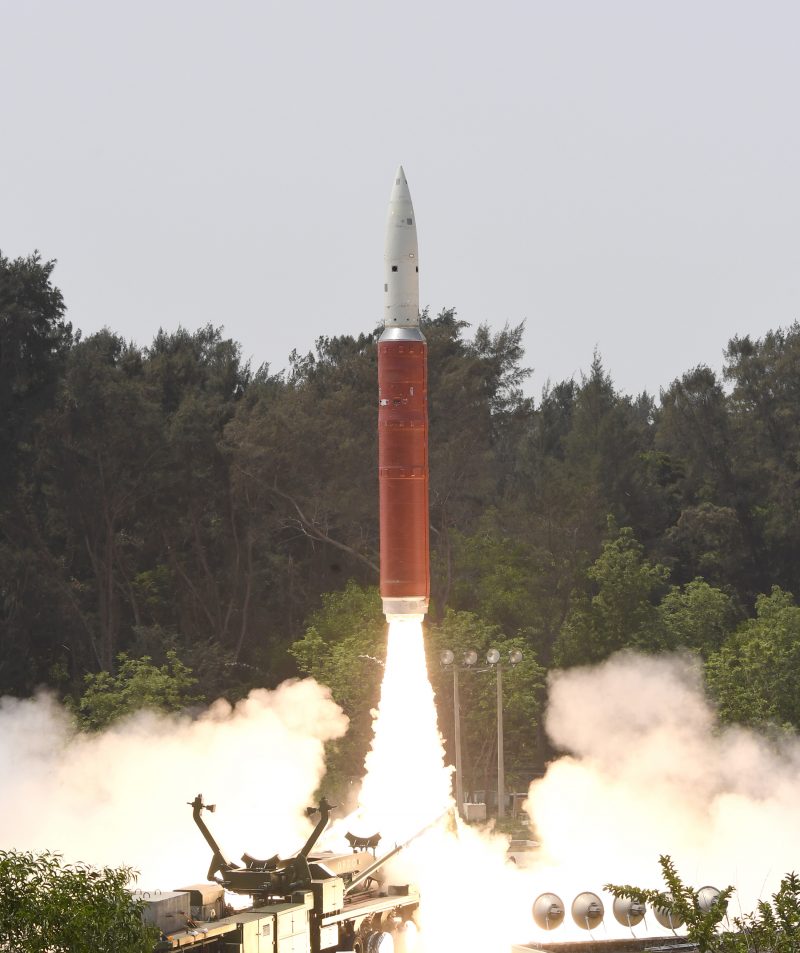A-SAT Test Makes India a Space Super Power – “Mission Shakti” Accomplished!
The Defense Research and Development Organization (DRDO) successfully launched the Ballistic Missile Defense (BMD) Interceptor missile, in an Anti-Satellite (A-SAT) missile test ‘Mission Shakti’ engaging an Indian orbiting target satellite in Low Earth Orbit (LEO) in a ‘Hit to Kill’ mode from the Dr. A.P.J. Abdul Kalam Island, in Odisha, March 27. (PIB)
India can pat itself on its back for successfully testing an anti-satellite, three-stage interceptor (A-Sat) missile, with the capability to destroy a satellite in space from the A.P.J. Abdul Kalam Island off Odisha coast, thereby gate-crashing into the super-exclusive club of nations – the U.S., Russia and China, who boast of having demonstrated this deadly capability, all on the basis of its indigenous technology.
Israel is the only other country believed to have this capability but has not demonstrated it so far.
The news of the brilliant execution of “Mission Shakti,” with technological, strategic and political implications, as announced in a televised address by Prime Minister Narendra Modi, is the fruit of two years of sheer preparation, simulation, and six months of mission mode by the Defense Research and Development Organization (DRDO) that received the go ahead for the Ballistic Missile Defense (BMD) program by the current NDA government despite having the “building blocks” for A-SAT capability through spin-offs from the over 5,000-km Agni-V strategic missile and the two-tier BMD programs for several years as it was on a self-imposed moratorium, under the Congress-led UPA – I & II governments, following the global condemnation of China’s first A-Sat test in 2007.
But with the 2007 shock New Delhi experienced a transformation in its ideas on proliferation that eventually gave way to a desire to pave way to tackle threats to its space assets that involved huge resources to develop and place them in space.
It may therefore be safe to conclude that the mission was a well thought out and carefully crafted program and as DRDO Chief Satheesh Reddy reveals with utmost pride, “The BMD program met all technical parameters and objectives in LEO or lower atmosphere, within 300 kilometers altitude even though it can go up to 1,000 km, to ensure the space debris decays and falls back to earth,” thus allaying concerns of “creating a mess of waste in space” as alleged by some.
Mission Shakti, a three stage missile with two solid rocket boosters, was set at a velocity of around 10km per second on a direct-ascent kinetic kill, targeted to hit Microsat-R launched on Jan. 24.
Strategically, this “satellite killer” is a plus for India in its plethora of deterrence and defense capabilities as it imparts an ability significantly required in the given circumstances of India that is not in a benign environment and is sandwiched between Pakistan, terror-exporting state on its west and China with a much advanced ASAT and sturdy programs for kinetic and directed-energy laser weapons and nano-satellites in the north and north-east, and the U.S. under the Trump administration withdrawing from the world, rather “leading from behind”,and hence posing the immediacy of transition of powers more so in Asia and outside.
Emphasizing on the reasons for India embarking on this space program Modi asserted, “Today, we are using space and satellites for all sorts of purposes, including agriculture, defense, disaster management, communication, entertainment, weather, navigation, education, medical uses, and other things. In such a situation, the security of these satellites is extremely important.”
Besides, the technology enables “neutralizing surveillance, communication, navigation and other military satellites during a conflict to render enemy forces deaf and blind as well as disrupt their precision-targeting capabilities.”
The March 27 launch and the PM’s televised address that were timed barely a fortnight before the nation holds its first phase of elections to the Lok Sabha have brewed sufficient controversy with the opposition ruing that the ruling party was flouting the model code of conduct of elections by embarking on programs that would buttress the tough as nail image of the incumbent PM to win votes.
Earlier in the month the national security image of BJP had been upped by several notches when it conducted air strikes on a Jaish-e-Muhammed terror camp in Balakot in Pakistan in the aftermath of the Pulwama attack.
Lauding the PM, his party persons and supporters present the perspective of salience of space program to India and the need of the hour of an authority of the level of the PM to assure the world community on India’s mission being peaceful in nature, defense and civilian oriented and not in violation of international commitments.
Stressing on this point Modi had reiterated, “Our aim is to maintain peace over war mongering. The space program’s aim is peace, India’s economic and technological progress.”
Regardless of which political dispensation is favored by this successful test and the timing of its launch it remains without doubt that India as a nation has benefitted by demonstrating a program that holds deterrence, strategic, and technological value.
Another point that demands attention is that India’s surprise demonstration of the A-SAT ability has enabled it to gatecrash the space club before the countries that had fulfilled their requirements tightened rules of entry similar to the times when doors were shut on new entrants by the Nuclear Non Proliferation Treaty, violation of which earned the newbie the status of a pariah.
But now with India’s test that stands to directly challenge to Beijing’s might that amounts to more than 250 satellites in the space domain, New Delhi will be amongst the contending powers who shall formulate rules of order and restraint in space, if ever in the future.
That scenario will be an immense opportunity for India to demonstrate its proficiency in coordinating with other countries to frame a consensus agreement, on multiple fora, and buttress its bid to being a real super power, one on whom the world at large can depend for ensuring peace for all and would not be beholden to another power.
Historically, India has always lived up to its principle of adhering to everyprinciple of ensuring peace and stability and it would be extremely naïve not to trust the Indian establishment in handling and deploying this capability in the interest of humanity.


